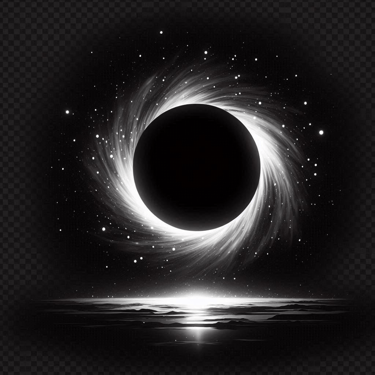Opinautics
Eric Sheldom. Sky and Telescope, august 1982 p.118.
4/1/20255 min read
Opinautics: A Matter of Much Gravity
As mentioned by Sky & Telescope magazine in its brief review of the Opinautics article: A Matter of Much Gravity, this artistic image created by Jon Lomberg depicts an Einstein ring — an amazing phenomenon that occurs when light from a distant galaxy passes near an extremely massive object, such as a black hole, which is aligned between that galaxy and Earth. The perfect geometric alignment of Earth – Black Hole – Galaxy is what allows the gravitational lensing effect to occur. The intense gravity of the black hole bends the light from the background galaxy, forming an almost perfect ring around the dark center. This effect, predicted by Albert Einstein, has allowed astronomers to observe distant objects in the universe with an astonishing level of detail.
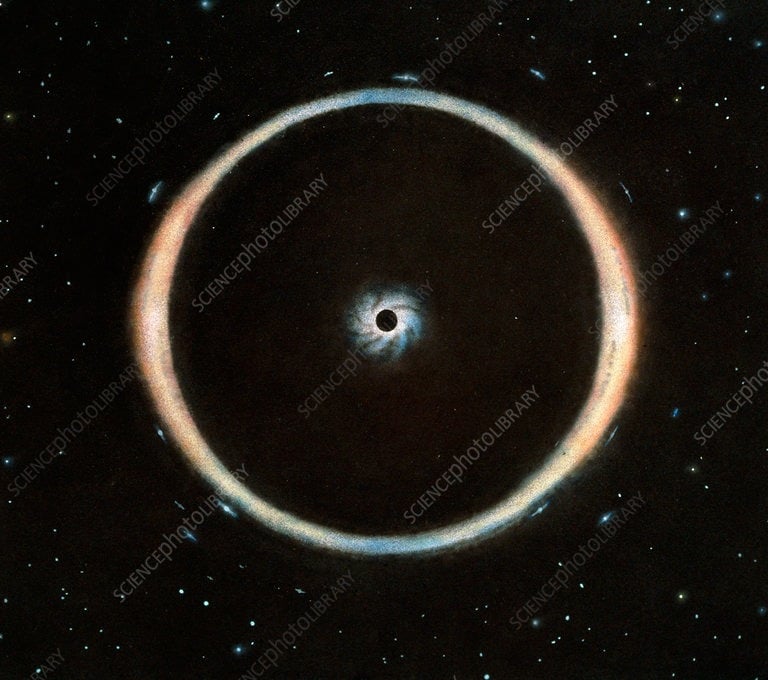

Types of Black Holes
For the sake of clarity, here are some of the types of black holes. All images and descriptions were generated by Chat Copilot.
Schwarzschild
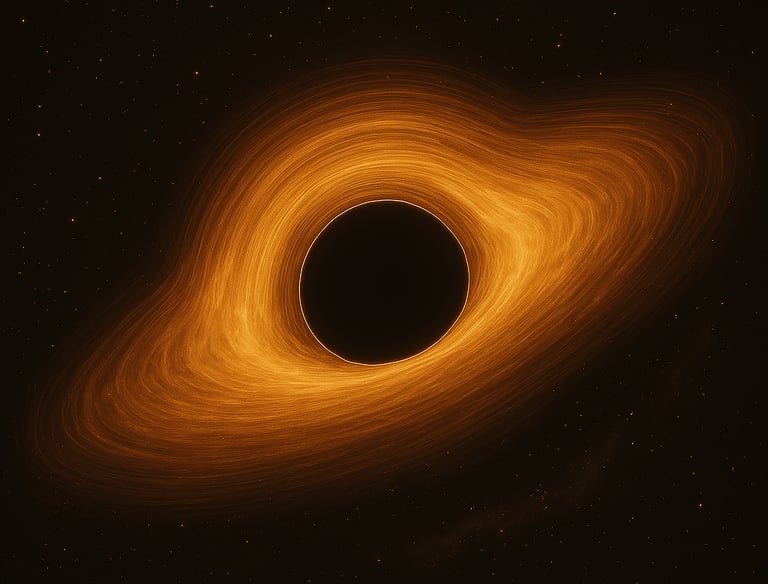

🌀This type of black hole is the simplest, with no charge or rotation, and a perfectly spherical event horizon.
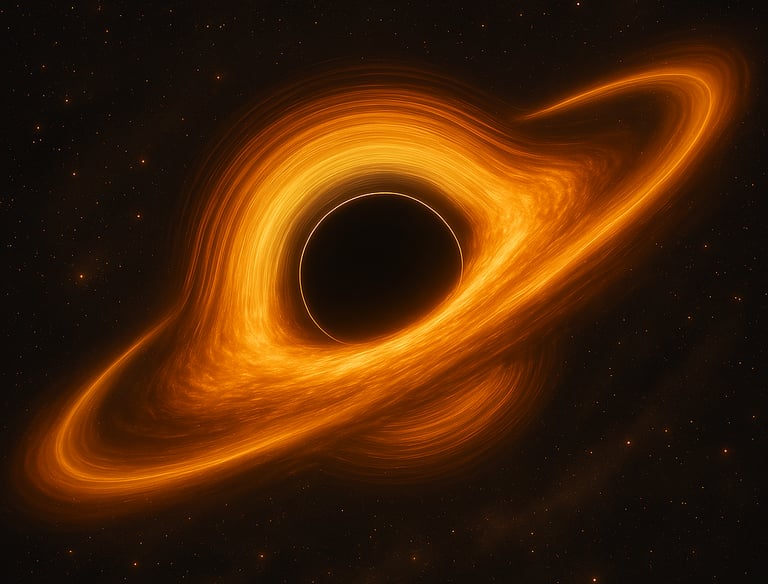

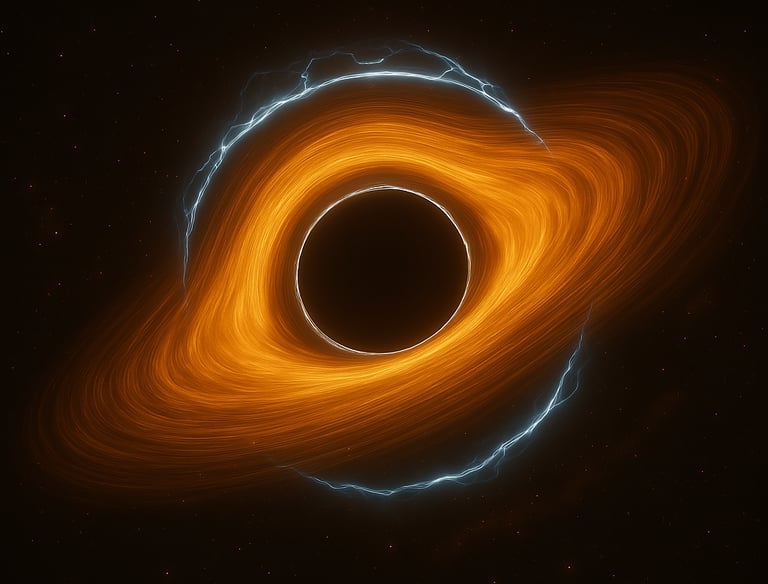

Kerr
🌀In contrast, this type of black hole rotates on its axis. Due to this rotation, its event horizon is distorted, forming more of an oval shape rather than a perfect sphere. Additionally, it has an extra region called the ergosphere, where spacetime itself is dragged due to its rotation. This effect creates a more dynamic image, with motion lines and pronounced spatial distortions.
⚡This type of black hole has an electric charge, which generates interesting effects on its gravitational field.
Reissner - Nordstramp
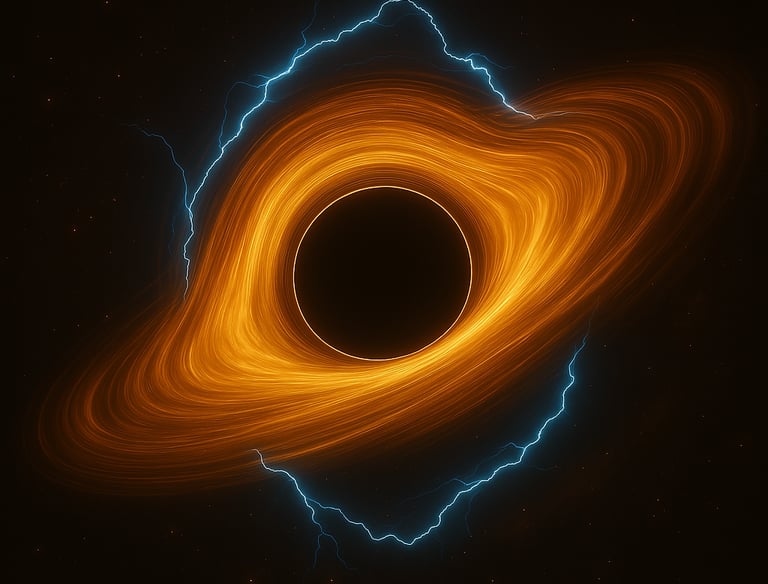

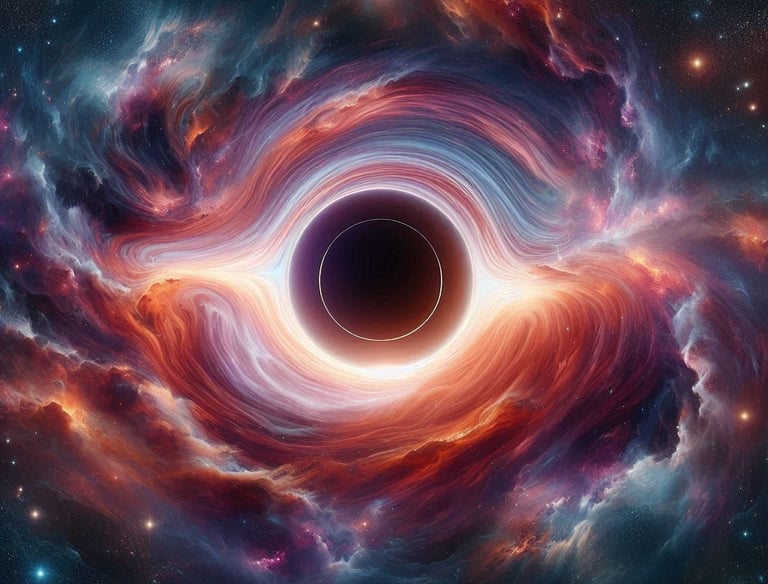

⚡🌌 This type of black hole has both electric charge and rotation, making it even more complex and fascinating.
Kerr - Newman
Primordial
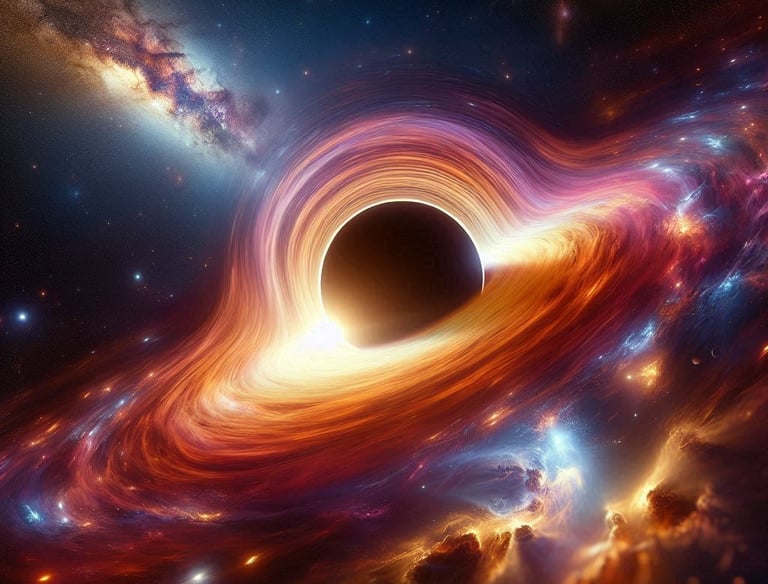

🌌Their image depicts a more expansive structure, with a large accretion disk illuminated by the matter falling into them, which is heated by extreme gravity.
Supermasive
⚫ Unlike stellar or supermassive black holes, their size can vary greatly, from microscopic masses to something comparable to an asteroid. Their image represents a more compact structure without a prominent accretion disk, as they may not be surrounded by enough matter to generate intense radiation.
-Consider a less bright image.
🚀 Exploring Science Fiction
Among the variety of podcasts I usually listen to, this is one of my favorites, the Punto Bernal Podcast. This podcast is made by Antonio Bernal González, science popularizer of the Fabra Observatory, in Barcelona, Spain. And Jorge Zuluaga, associate professor at the Institute of Physics of the University of Antioquia, Medellín, Colombia. In minute 43:33 of an episode called Monsters at the Center of Galaxies, Antonio mentions that navigation near or through a black hole is called opinautics, which appeared in the magazine Sky & Telecospe, 1982. This idea was so resonant for me that I needed to know more about it. When I searched on the internet I was surprised to find that there is not much information about it, just a few references, but no access to the document. Finally I found out that the magazine was on sell on eBay so we bought it.
With the purpose of sharing some of the key ideas from the article, without infringing copyright laws, here is a short review:
There are three important characteristics for determining different types of black holes: spin, mass, and charge. This is crucial because it helps identify which black holes are potentially "navigable."
Uncharged black holes, such as Kerr black holes, generate an ergosphere with a pumpkin-like shape, covering the event horizon or singularity. The Kerr black hole is more complex because it has spin, while the Schwarzschild type has neither charge nor rotation. Approaching a Schwarzschild black hole is highly inadvisable because one would encounter the event horizon directly. In contrast, a Kerr black hole presents a highly risky—but theoretically possible—way to approach it.
A Kerr black hole could be reached via the axial axis perpendicular to the rotation axis. As one attempts to enter the singularity, it becomes increasingly difficult to approach the center due to the equatorial forces created by spacetime dragging within the ergosphere.
Since there is no hope of returning, the best possible outcome would be to find a future segment to move toward. If the "opinauts" are lucky, they might find a future similar and hopefully close to the universe they left behind.
The author presents one of the Penrose diagrams, where segments or regions of time are represented as different rhombuses stacked underneath. These spacetime segments correspond to universes from the ultra-past, infra-past, present, future, and ultra-future, as well as other universes and anti-universes. However, all these possibilities do not appear in every black hole; rather, they depend on the spacetime configuration resulting from the astrophysical characteristics of each one.
In the magazine, the author presents these diagrams as beautifully colored rhombuses. One of them conveys the idea of a spiral formed by rhombuses or a spiny wand created by the union of small squares rotated 45°. From these configurations, information is being emitted to the observing "opinaut"—events that have happened, are happening, and will happen—light coming from ultra-pasts and/or ultra-futures.- 🚀🚀🚀
... But, for sure, the opinauts already knew all this.
Here we have the Penrose's Diagrams for the Kerr's and Schwarzschild's black holes and a infinite Mikowsky universe:
SOME REMINDERS FOR OPINAUTS
⚫ About the article of Eric Sheldom on Sky and Telescope, august 1982, p.118. Called: OPINAUTICS: A MATTER OF MUCH GRAVITY
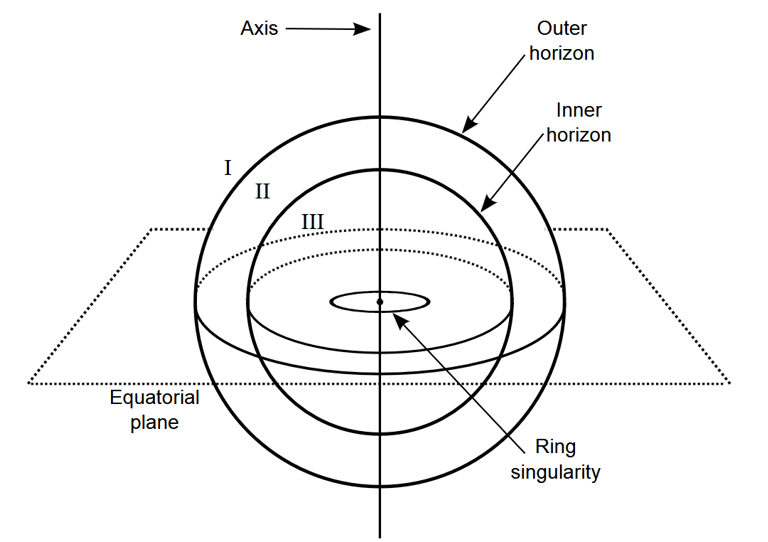

Figure 1. "Figure 3. Sketch of a Kerr black hole, with its two horizons and the ring singulatrity." (Romero, G. E., 2014, p.12)
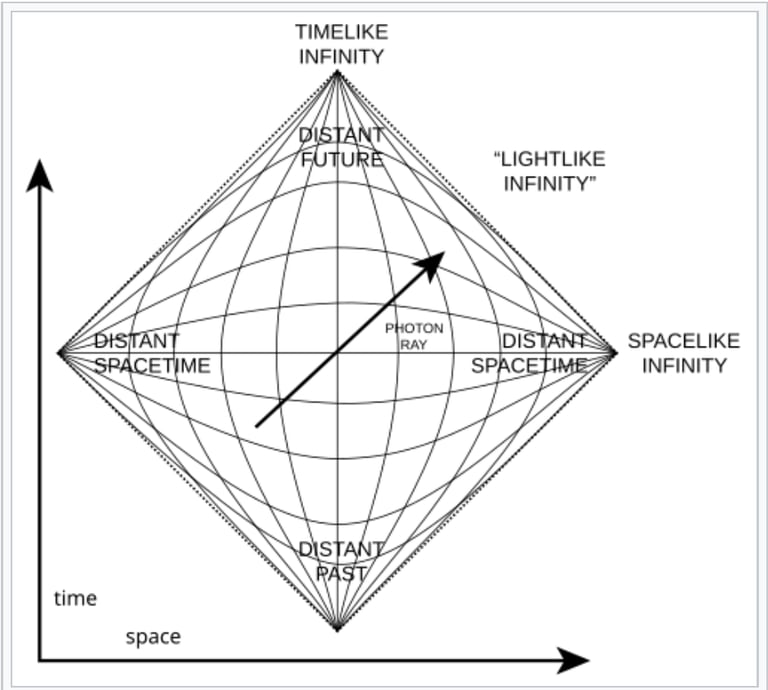

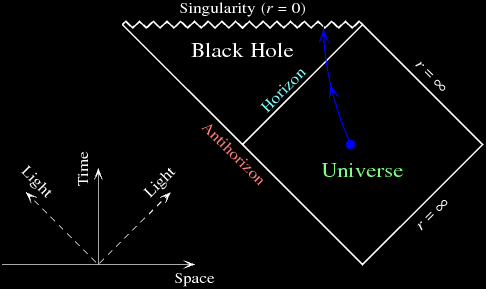

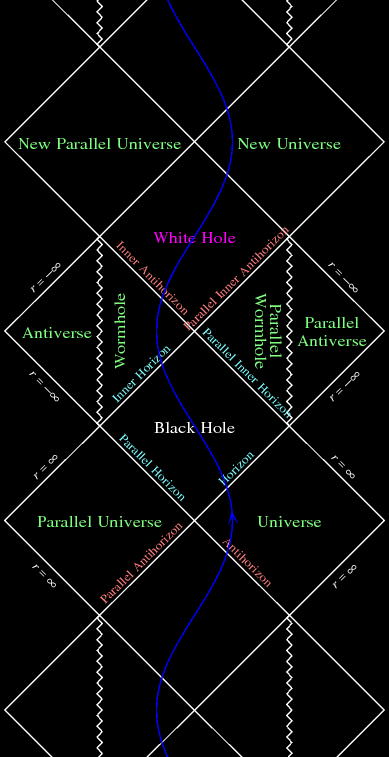

Figura 2. Penrose diagrams of a infinite Minkowski universe, axis horizontal u, axis vertical v.
Figure 3. Penrose diagram of Schwarzschild's black hole. JILA a joint instute of CBU and NIST.
Figure 4. Penrose diagram of Kerr's black hole. JILA a joint instute of CBU and NIST.
REFERENCES
Romero, G. E. (2014). Philosophical Issues of Black Holes. http://arxiv.org/abs/1409.3318
Sheldom, E. (1982). Opinautics: A Matter of Much Gravity. Sky and Telescope, august 1982, vol 62 N°. 2.
CYBERGRAPHY
[1]. Penrose_diagram.svg: https://en.wikipedia.org/wiki/Penrose_diagram
[2]. JILA a joint instute of CBU and NIST. https://jila.colorado.edu/~ajsh/insidebh/penrose.html
[3]. https://copilot.microsoft.com/chats/6fMc1PhnoTc5z1iVkh8Af
Regarding figure 4: Imagine the opinauts made it happen, traveling through the axial axis (perpendicular to the rotation axis) of the black hole, finding the event horizon, and crossing it to discover all these other universes.
Would we be awaiting infinite solitude or a fully interconnected future universe?
